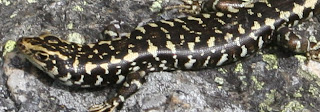Science is not always straight forward it is about trying things out and overcoming problems.
Over the last few weeks I have been conducting some trials to see if
we capture lizards on remote cameras.
We have had to overcome the problem that the remote cameras are set up to pick up movement of animals based on infrared rays. That is the camera uses heat and movement however reptiles are cold blooded
therefore the infrared sensor may not always work.
How do we overcome this problem?
Firstly we have to wait to the sun comes out so the skinks can warm up then the camera may be able to pick them up.
We set up a trial to see what would happen.
In the picture you may notice some boards these are so that there to make it easier to pick up the skinks as they are hard to pick up against a dirt background
However then we came across another problem - that the wind may be setting of the camera not the skinks.
So how do you think we overcame this problem?
What did we find?
So far the results are not conclusive we are getting some pictures of the skinks but not on a regular basis. For example when its a cloudy day we didn't get any pictures.
If anyone has any ideas about how we could capture lizards especially skinks on a remote camera please get in touch
.jeremyhogue32@gmail.com
or leave a comment on this site.
Thanks David for your comment- and yes we have thought about setting it to time lapse however we will use this option only if we have to - we are trying to avoid having to trawl through thousands of photos.
This is what the camera looks like when set up in the field.




